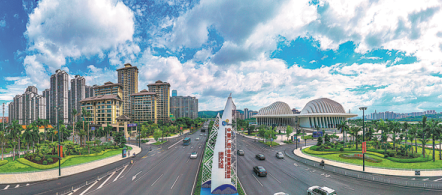Free trade zone boosts connection and attracts enterprise investment

The China (Guangxi) Pilot Free Trade Zone is committed to becoming an international investment and trade pilot zone aimed at ASEAN members. LU YILIN/FOR CHINA DAILY
The China (Guangxi) Pilot Free Trade Zone is making full use of its geographical advantages, engaging members of the Association of Southeast Asian Nations, and helping promote market expansion, information exchanges and coordinated industrial development between the Guangxi Zhuang autonomous region and its neighbors.
Established in August 2019, the free trade zone is committed to becoming an international investment and trade pilot zone aimed at ASEAN members.
The free trade zone is working to accelerate multiple sectors, including the cross-border automobile industry for ASEAN, the electronic information industry, new materials, ASEAN-featured products, traditional Chinese medicine, finance, logistics and the digital economy.
Over the past two years, the China (Guangxi) Pilot Free Trade Zone has held more than 50 promotional events both online and offline. More than 100 investment promotion activities were held in China's major economic development areas. These include the Guangdong-Hong Kong-Macao Greater Bay Area, Yangtze River Delta region and Beijing-Tianjin-Hebei region.
As of the end of July, the free trade zone has attracted nearly 40,000 enterprises. Among them is an asset management company, named after Qiyuan.
"We are innovating to realize industrial investment and capital guidance in a market-oriented way, and have introduced a group of high-quality enterprises with superior abilities in industrial cooperation with ASEAN," said Yang Xin, president of Qiyuan.
To better cooperate with ASEAN and the Regional Comprehensive Economic Partnership, the China (Guangxi) Pilot Free Trade Zone has set up a China-ASEAN economic and trade center. It aims to speed up the establishment of a China-ASEAN commodity trading platform.
From January to July, the free trade zone achieved an import and export volume of 113.6 billion yuan ($17.6 billion), up 25 percent from the same period in 2020. It also attracted a total foreign investment of $260 million in the same period, soaring 330 percent year-on-year.
In late August, the China (Guangxi) Pilot Free Trade Zone announced that it had explored and implemented 44 institutional innovations in the zone over the past two years, which is expected to add momentum to its development.
Focusing on cooperation with ASEAN and further opening-up, the free trade zone has initiated a multimodal transportation system that integrates the transport of both railway containers and maritime containers to increase efficiency.
In addition, the free trade zone has accelerated data and information connectivity with some ASEAN members, such as Singapore.
Thanks to the innovative measures taken by the free trade zone, the Qinzhou Port in the zone achieved an overall clearance time of 16.88 hours in the first seven months this year. This was 19.91 fewer hours than that of 2020, jumping to a national first-class level.
The China (Guangxi) Pilot Free Trade Zone is also working on building an open financial ecosystem, which features China-ASEAN cross-border financial reform and innovation.
Statistics show that by June, the volume of cross-border RMB settlement in Guangxi had reached 1.37 trillion yuan, ranking first among the 12 provinces and autonomous regions in western China.
Looking ahead, the free trade zone will continue to develop itself into a high-standard and high-quality zone, to support China-ASEAN cooperation and promote China's dual-circulation development paradigm, said Yang Chunting, director of the Department of Commerce of the Guangxi Zhuang autonomous region.


